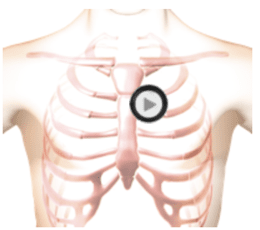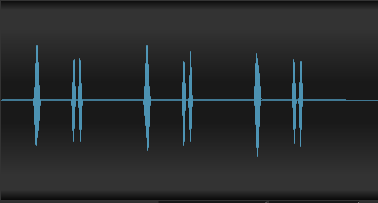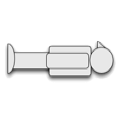This example shows fixed splitting of the second heart sound. The separation of the two components of the second heart sound remains unchanged through inspiration and expiration at sixty milliseconds in this example.
Fixed splitting of the second heart sound (along with murmurs) indicates the presence of an atrial septal defect, a congenital heart defect in which the intra-atrial septum is incomplete resulting in a hole between the left and right atria.
The murmurs have been eliminated in this lesson so that you can concentrate on the fixed splitting of the second heart sound.
Second Heart Sound - Fixed Splitting 84 Audio


Second Heart Sound - Fixed Splitting 84 Sounds


Half Speed Second Heart Sound - Fixed Splitting 84 Sounds


Technique

The patient's position should be supine.
Auscultation Tips for Second Heart Sound - Fixed Splitting 84
S2:Fixed SplittingSound Wave
Second Heart Sound - Fixed Splitting 84 Video
Authors and Sources
Authors and Reviewers
- ECG heart rhythm modules: Thomas O'Brien.
- ECG monitor simulation developer: Steve Collmann
-
12 Lead Course: Dr. Michael Mazzini, MD.
- Spanish language ECG: Breena R. Taira, MD, MPH
- Medical review: Dr. Jonathan Keroes, MD
- Medical review: Dr. Pedro Azevedo, MD, Cardiology
- Last Update: 11/8/2021
Sources
-
Electrocardiography for Healthcare Professionals, 6th Edition
Kathryn Booth and Thomas O'Brien
ISBN10: 1265013470, ISBN13: 9781265013479
McGraw Hill, 2023 -
Rapid Interpretation of EKG's, Sixth Edition
Dale Dublin
Cover Publishing Company -
EKG Reference Guide
EKG.Academy -
12 Lead EKG for Nurses: Simple Steps to Interpret Rhythms, Arrhythmias, Blocks, Hypertrophy, Infarcts, & Cardiac Drugs
Aaron Reed
Create Space Independent Publishing -
Heart Sounds and Murmurs: A Practical Guide with Audio CD-ROM 3rd Edition
Elsevier-Health Sciences Division
Barbara A. Erickson, PhD, RN, CCRN -
The Virtual Cardiac Patient: A Multimedia Guide to Heart Sounds, Murmurs, EKG
Jonathan Keroes, David Lieberman
Publisher: Lippincott Williams & Wilkin)
ISBN-10: 0781784425; ISBN-13: 978-0781784429 - Project Semilla, UCLA Emergency Medicine, EKG Training Breena R. Taira, MD, MPH
-
ECG Reference Guide
PracticalClinicalSkills.com
Second Heart Sound - Fixed Splitting 84 | #120